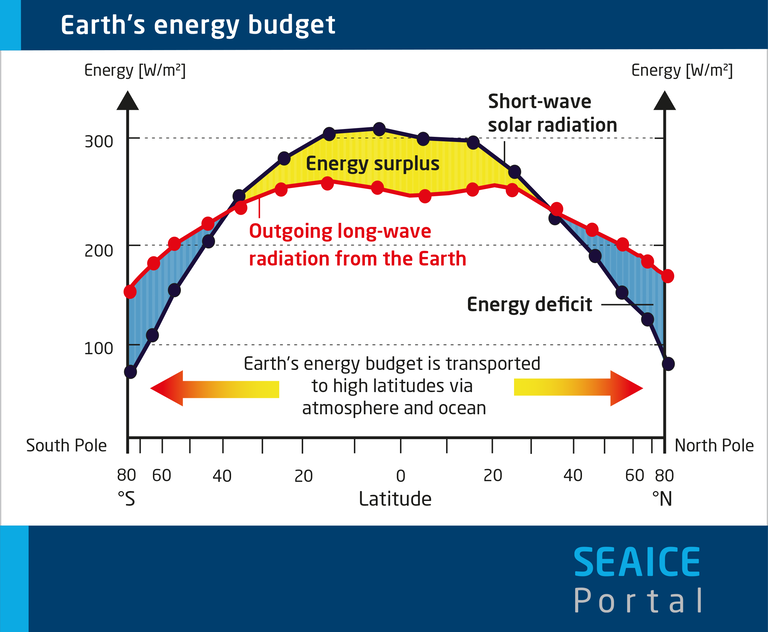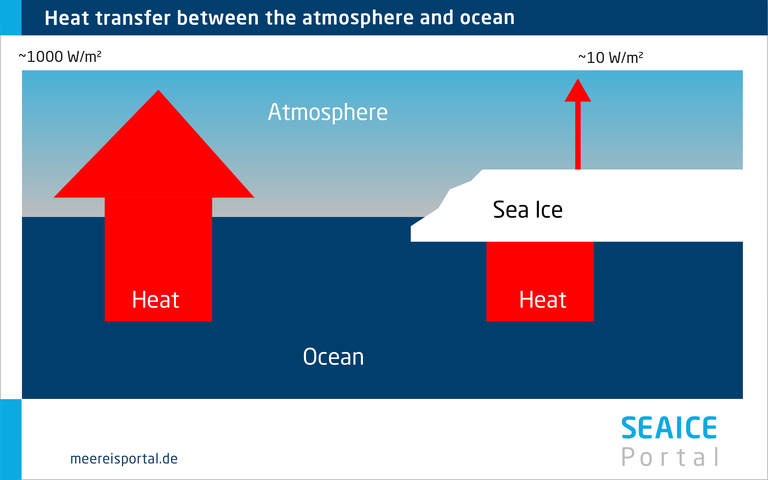Sea Ice and Atmosphere
Dropping to –40 degrees Celsius in winter, the atmosphere over the polar seas is usually far colder than the topmost water layer. In keeping with the laws of thermodynamics, this considerable temperature gradient between the water and air produces substantial upward heat transfer. Accordingly, the atmosphere absorbs a great deal of heat from the water. When the ocean’s upper mixed layer cools to the freezing point, it forms sea ice, which insulates the comparatively warm seawater from the frigid polar air, greatly limiting further heat transfer. Sea ice reduces heat transfer between the ocean and atmosphere by two orders of magnitude, from ca. 1000 W/m² to ca. 10 W/m².
The polar regions have a significant influence on Earth’s energy budget and the dynamics of the atmosphere. Due to their high albedo, ice and snow reflect much of the incoming short-wave solar radiation back into space. Consequently, at the poles the energy lost through the Earth’s own long-wave radiation exceeds the energy gained via absorbed sunlight, yielding a net loss (energy deficit). In lower latitudes near the Equator, just the opposite is true: there is an energy surplus because more energy in the form of sunlight is absorbed than is emitted by the Earth. The energy surplus in the low latitudes and energy deficit in the high latitudes are reconciled by energy transfer from the Equator to the poles. This meridional energy transport is achieved by atmospheric and oceanic circulation, which is triggered by the temperature difference between the Equator and poles.
Sea ice also affects the exchange of momentum between the ice, ocean and atmosphere. For example, sea ice has a much higher surface roughness than water, offering the wind more purchase (transfer of wind energy through friction). Accordingly, wind, together with ocean currents, determines the sea-ice drift, i.e., the transport of large ice floes across the ocean.
Due to the low temperatures over the ice near the poles, air masses sink. This produces a massive low-pressure cell over the sea ice. Because of the Coriolis force, the downflowing air forms a counter-clockwise-turning polar vortex, which largely blocks any exchanges of air masses with the lower latitudes. As a result, especially in winter, both inflows of warm air and outflows of cold air are rarely seen. Certain mechanisms can weaken polar vortexes. From time to time, the vortex over the Arctic becomes unstable, leading to outbreaks of frigid polar air that can produce extreme cold snaps in the moderate latitudes. At the same time, this allows warm air to reach the High North, where it produces veritable heat waves.


